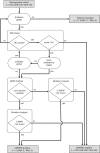Constitutional mismatch repair deficiency is the diagnosis in 0.41% of pathogenic NF1/SPRED1 variant negative children suspected of sporadic neurofibromatosis type 1
- PMID: 32773772
- PMCID: PMC7708300
- DOI: 10.1038/s41436-020-0925-z
Constitutional mismatch repair deficiency is the diagnosis in 0.41% of pathogenic NF1/SPRED1 variant negative children suspected of sporadic neurofibromatosis type 1
Abstract
Purpose: Biallelic germline mismatch repair (MMR) gene pathogenic variants (PVs) cause constitutional MMR deficiency (CMMRD), a highly penetrant childhood cancer syndrome phenotypically overlapping with neurofibromatosis type 1 (NF1). CMMRD testing in suspected NF1 children without NF1/SPRED1 PVs enables inclusion of CMMRD positives into monitoring programs prior to tumor onset. However, testing is associated with potential harms and the prevalence of CMMRD among these children is unknown.
Methods: Using a simple and scalable microsatellite instability (MSI) assay of non-neoplastic leukocyte DNA to detect CMMRD, we retrospectively screened >700 children suspected of sporadic NF1 but lacking NF1/SPRED1 PVs.
Results: For three of seven MSI-positive patients germline MMR gene PVs confirmed the diagnosis of CMMRD. Founder variants NM_000535.5(PMS2):c.736_741delinsTGTGTGTGAAG, prevalent in Europe and North America, and NM_000179.2(MSH6):c.10C>G, affecting 1:400 French Canadians, represented two of five PVs. The prevalence of CMMRD was 3/735 (0.41%, 95% confidence interval [CI]: 0.08-1.19%).
Conclusion: Our empirical data provide reliable numbers for genetic counseling and confirm previous prevalence estimations, on which Care for CMMRD consortium guidelines are based. These advocate CMMRD testing of preselected patients rather than offering reflex testing to all suspected sporadic NF1 children lacking NF1/SPRED1 PVs. The possibility of founder effects should be considered alongside these testing guidelines.
Keywords: childhood cancer; constitutional mismatch repair deficiency; founder variant; microsatellite instability; neurofibromatosis type 1.
Conflict of interest statement
R.G., M.S.-K., M.S.J., and J.B. are named as inventors on patents held by Newcastle University, UK, covering the markers used in the MSI assay used in this study (patent ID: PCT/GB2017/052488, published 1 March 2018; and PCT application number: PCT/GB2019/052148, unpublished, filing date 31 July 2019). The other authors declare no conflicts of interest.
Figures

References
Publication types
MeSH terms
Substances
Supplementary concepts
Grants and funding
LinkOut - more resources
Full Text Sources
Other Literature Sources
Medical
Research Materials
Miscellaneous

